March 2006
The use of pesticides to control weeds, insects, and other pests has resulted in a range of benefits, including increased food production and reduction of insect-borne disease, but also raises questions about possible adverse effects on the environment, including water quality. A decadal assessment by the National Water-Quality Assessment (NAWQA) Program of the United States Geological Survey (USGS) provides the most comprehensive national-scale analysis to date of pesticide occurrence and concentrations in streams and ground water, based on results from studies completed during 1992–2001. Among the major findings are that pesticides are frequently present in streams and ground water, are seldom at concentrations likely to affect humans, but occur in many streams at concentrations that may have effects on aquatic life or fish-eating wildlife. This Fact Sheet highlights national findings regarding pesticide occurrence, distribution and sources, and the potential for effects on humans, aquatic life, and fish-eating wildlife. It serves as a companion product to the USGS Circular entitled "The Quality of Our Nation's Waters—Pesticides in the Nation's Streams and Ground Water, 1992–2001."
Pesticides and degradates are typically present throughout most of the year in streams draining watersheds with substantial agricultural or urban areas, but are less common in ground water.
At least one pesticide was detected in water from all streams studied and, as shown in the graph below, pesticide compounds were detected throughout most of the year in water from streams with agricultural (97 percent of the time), urban (97 percent), or mixed-land-use watersheds (94 percent). In addition, organochlorine pesticides (such as DDT) and their degradates and by-products were found in fish and bed-sediment samples from most streams in agricultural, urban, and mixed-land-use watersheds—and in more than half the fish from streams with predominantly undeveloped watersheds. Most of the organochlorine pesticides have not been used in the United States since before the NAWQA studies began, but their continued presence demonstrates their persistence in the environment.
Pesticides were less common in ground water than in streams. They occurred most frequently in shallow ground water beneath agricultural and urban areas, where more than 50 percent of wells contained one or more pesticide compounds. About one-third of the deeper wells sampled, which tap major aquifers used for water supply, contained one or more pesticides or degradates.
The findings show that streams are most vulnerable to pesticide contamination, but ground water also merits careful monitoring—especially in agricultural and urban areas. Shallow ground water in some of these areas is used for drinking water and ground-water contamination is difficult to reverse once it occurs.
The occurrence of pesticides in streams and ground water does not necessarily cause adverse effects because detections were often at low concentrations. NAWQA's assessment of potential effects is based on comparing measured concentrations to water-quality benchmarks, as described on the following page. Benchmarks are estimates of the concentrations above which pesticides may have adverse effects on humans, aquatic life, or fish-eating wildlife. For example, less than 10 percent of NAWQA stream sites and about 1 percent of wells had concentrations greater than a human-health benchmark.
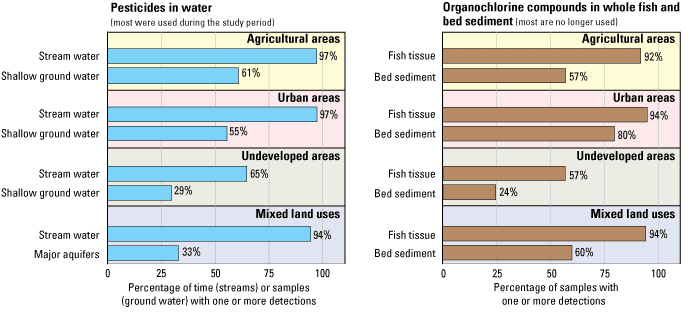
Concentrations of pesticides in streams and ground water were typically below water-quality benchmarks for human health.
No streams draining undeveloped watersheds and only one stream with a mixed-land-use watershed had concentrations greater than a human-health benchmark. Annual mean concentrations of one or more pesticides exceeded a human-health benchmark in 8 of 83 agricultural streams and in 2 of 30 urban streams. Agricultural streams located in the Corn Belt (Illinois, Indiana, Iowa, Nebraska, Ohio, and parts of adjoining States) and the Mississippi River Valley accounted for most concentrations that exceeded benchmarks—all by atrazine, cyanazine (no longer in use by the end of the study), or dieldrin (no longer in use when the study began). The two urban streams where benchmarks were exceeded are in Texas (diazinon) and Hawaii (dieldrin).
None of the NAWQA stream sites were located at drinking-water intakes. For perspective, however, the Nation's 1,679 public water-supply intakes on streams were evaluated in the context of NAWQA land-use classifications and pesticide findings. Eighty-seven percent of the water-supply intakes are on streams draining undeveloped and mixed-land-use watersheds and are therefore unlikely to withdraw water with concentrations that are greater than a human-health benchmark. The likelihood of pesticide concentrations exceeding a human-health benchmark is greatest for those streams draining agricultural or urban watersheds, which account for about 12 and 1 percent, respectively, of public water-supply intakes on streams.
Human-health benchmarks were seldom exceeded in ground water. One or more pesticides exceeded a benchmark in about 1 percent of the 2,356 domestic and 364 public-supply wells that were sampled. The greatest proportion of wells with a pesticide concentration greater than a benchmark was for those tapping shallow ground water beneath urban areas (4.8 percent). The urban wells with benchmark exceedances included 1 public-supply, 3 domestic, and 37 observation wells. All concentrations greater than a benchmark were accounted for by dieldrin (72 wells), dinoseb (4), atrazine (4), lindane (2), and diazinon (1).
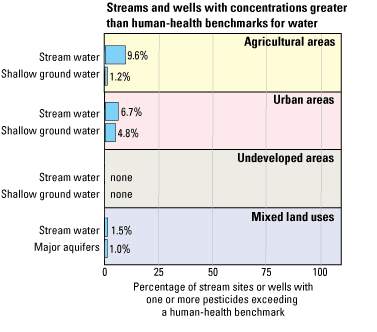
The potential for pesticides to adversely affect human health, aquatic life, or fish-eating wildlife was evaluated by a screening-level assessment similar in concept to U.S. Environmental Protection Agency (USEPA) screening-level assessments. The screening-level assessment is primarily intended to identify and prioritize needs for further investigation and is not a substitute for comprehensive risk assessment, which includes additional factors. Concentrations of pesticides measured at NAWQA sampling sites were compared with water-quality benchmarks derived from standards and guidelines established by USEPA, toxicity values from USEPA pesticide risk assessments, and selected guidelines from other sources. Most of the benchmarks are estimates of no-effect levels, such that concentrations below the benchmarks are expected to have a low likelihood of adverse effects and concentrations above a benchmark may have adverse effects, with the likelihood increasing as the concentration increases.
Concentrations of pesticides were greater than water-quality benchmarks for aquatic life and (or) fish-eating wildlife in more than half of the streams with substantial agricultural and urban areas in their watersheds.
Of the 178 streams sampled nationwide that have watersheds dominated by agricultural, urban, or mixed land uses, 56 percent had one or more pesticides in water that exceeded at least one aquatic-life benchmark. Urban streams had concentrations that exceeded one or more benchmarks at 83 percent of sites—mostly by the insecticides diazinon, chlorpyrifos, and malathion—although frequencies of exceedance declined during the study period. Concentrations exceeded benchmarks in 95 percent of urban streams sampled during 1993–1997 and in 64 percent of streams during 1998–2000. Agricultural streams had concentrations that exceeded one or more benchmarks at 57 percent of sites—most frequently by chlorpyrifos, azinphos-methyl, atrazine, p,p'-DDE, and alachlor. As the use of alachlor declined through the study period, its benchmark exceedances also declined, with none during the last 3 years of study.
Aquatic-life benchmarks for organochlorine pesticide compounds in bed sediment also were frequently exceeded in urban areas (70 percent of urban stream sites). Most compounds that exceeded aquatic-life benchmarks for sediment were derived from organochlorine pesticides that have not been used since before the study began, such as DDT, chlordane, aldrin and dieldrin. In agricultural streams, aquatic-life benchmarks were exceeded at 31 percent of sites—most often by DDT compounds and dieldrin.
Comparisons of concentrations of organochlorine compounds in whole fish with wildlife benchmarks indicate a wide range of potential for effects on fish-eating wildlife. The ranges of percentages shown on the graph below reflect the uncertainties in benchmarks for fish-eating wildlife due to the lack of consensus on national-scale benchmarks or toxicity values. Similar to bed sediment, benchmarks for fish were exceeded most often by compounds related to DDT, dieldrin, and chlordane in urban streams, and by DDT compounds, dieldrin, and toxaphene in agricultural streams in areas where historical use on crops was most intense.
Assessment and management of the potential effects of pesticides on aquatic life and wildlife are complicated by the combined presence in streams of (1) currently used pesticides and degradates, and (2) organochlorine pesticide compounds derived from pesticides that were largely banned prior to 1990. The widespread potential for adverse effects shown by the screening-level assessment—combined with the uncertainty due to the preliminary nature of the assessment and the complexity of pesticide exposure—indicate a continuing need to study the effects of pesticides on aquatic life and wildlife under the conditions of pesticide exposure that occur in the environment.
Pesticides detected most frequently in streams and ground water are among those used most heavily during the study or in the past. Their occurrence follows patterns in land use and use intensity, with additional influence—especially for ground water—by natural factors and management practices.
The most frequently detected herbicides that are used mainly for agriculture—atrazine, metolachlor, cyanazine, alachlor, and acetochlor—generally were detected most often and at the highest concentrations in water samples from streams in agricultural areas with their greatest use, particularly in the Corn Belt. Five herbicides commonly used in urban areas—simazine, prometon, tebuthiuron, 2,4-D, and diuron—and three commonly used insecticides—diazinon, chlorpyrifos, and carbaryl—were most frequently detected in urban streams throughout the Nation, often at higher concentrations than in agricultural streams. Total DDT was measured at some of the highest concentrations in bed sediment and fish in parts of the Southeast and in parts of California, Oregon, and Washington, where DDT was historically used on cotton, tobacco, orchards or other crops.
Land use and pesticide use are not the only factors influencing the occurrence of pesticides. Natural features and land-management practices also affect their distribution, particularly in ground water. Ground water is most vulnerable to contamination in areas with highly permeable soil and aquifer materials and where drainage practices do not divert recharge to streams and other surface water.
Pesticide concentrations in stream water also vary by season, with lengthy periods of low concentrations punctuated by seasonal pulses of much higher concentrations. For example, in streams that drain farmland throughout most of the Corn Belt, concentrations of herbicides were generally highest during spring runoff following pesticide applications. Similarly, concentrations of diazinon were highest during the winter in parts of the San Joaquin Valley, California, when applications to dormant almond orchards were followed by rainfall.
Understanding the correlations of pesticide occurrence with the amounts and characteristics of pesticides used can help managers to anticipate and prioritize the pesticides most likely to affect water quality in different land-use settings. Some hydrologic settings where ground water is least vulnerable to contamination are those where streams are most vulnerable, and vice versa. The entire hydrologic system and its complexities, therefore, need to be considered in evaluating the potential for pesticide contamination of streams and ground water. In addition, seasonal patterns in pesticide concentrations are important to consider, both in managing the quality of drinking water withdrawn from streams in agricultural and urban settings and in evaluating the potential for adverse effects on aquatic life. Effective management of streams may require increased monitoring—including high-frequency sampling during seasons when intense pesticide use coincides with periods of high runoff—so that periods with elevated pesticide concentrations are adequately characterized.

Pesticides most commonly occur as mixtures of multiple compounds, rather than individually, including degradates resulting from the transformation of pesticides in the environment.
Streams in agricultural and urban areas almost always contained complex mixtures of pesticides and degradates. More than 90 percent of the time, water samples from streams with agricultural, urban, or mixed-land-use watersheds contained 2 or more pesticides or degradates, and about 20 percent of the time they had 10 or more. Mixtures were less common in ground water. Nevertheless, about half of the shallow wells in agricultural areas and about a third of shallow wells in urban areas contained 2 or more pesticides and degradates—less than 1 percent had 10 or more. The herbicides atrazine (and its degradate, deethylatrazine), simazine, metolachlor, and prometon were common in mixtures found in streams and ground water in agricultural areas. The insecticides diazinon, chlorpyrifos, carbaryl, and malathion were common in mixtures found in urban streams.
Degradates are often as common in streams and ground water as their parent pesticides. For example, atrazine, the most heavily used herbicide in the Nation during the study period, was found together with one of its several degradates, deethylatrazine, in about 75 percent of stream samples and about 40 percent of ground-water samples collected in agricultural areas across the Nation. Degradates are particularly important in ground water, which moves relatively slowly through soils and aquifers, providing the extended time and conditions favorable for transformation of pesticides. Most degradates are less toxic than their parent pesticide, but some have similar or greater toxicities.
The widespread and common occurrence of pesticide mixtures, particularly in streams, means that the total combined toxicity of pesticides in water and other media often may be greater than that of any single pesticide compound that is present. Continued research is needed on the potential toxicity of pesticide mixtures, including degradates, to humans, aquatic life, and wildlife. NAWQA data on the occurrence and characteristics of mixtures and degradates is helping to target and prioritize toxicity assessments.
National-scale modeling and prediction of pesticide levels in unmonitored areas is increasingly possible for some pesticides, particularly for streams.
NAWQA data are sufficiently extensive to support national statistical models that can be used to estimate the concentrations or occurrence of some pesticides in streams and ground water where they have not yet been measured. Such spatial extrapolation is fundamental to extending NAWQA's findings on sources and factors that affect pesticide occurrence —such as pesticide use and land use, climate, and soil characteristics—to a more comprehensive national assessment that includes unmonitored areas. The NAWQA model for atrazine in streams, for example, can be used to predict the likelihood that the annual average concentration of atrazine in untreated stream water exceeds the USEPA drinking-water standard of 3 micrograms per liter in any stream in the Nation (see map below). Atrazine concentrations were predicted to be highest in the Corn Belt and parts of the southern Mississippi River Valley, where use is high and natural features favor the transport of pesticides by runoff to streams. Streams shown in red on the map are estimated to have more than a 5-percent chance of having an annual mean concentration greater than the USEPA standard. Some of these streams may not be suitable as sources of drinking water without the use of strategies to lower concentrations. These types of analyses can be used to identify locations that have the greatest likelihood of water-quality problems and that are the highest priority for additional monitoring.
Expanding the capability for prediction and extrapolation is a critical step for national water-quality assessment, as well as for cost-effective management of water resources, because both require more information (pesticides, places, and times) than can be directly measured.
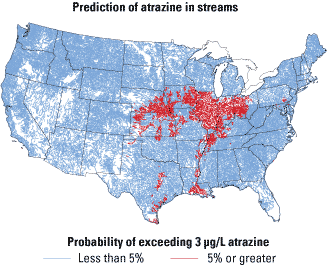
Some trends in pesticide concentrations are already evident, showing responses to regulatory actions and reduced use.
NAWQA findings provide a framework for assessing whether pesticide levels in the Nation's streams and ground water are increasing or decreasing over time. For many streams and aquifers, it is too early to tell whether levels are changing, because historical data are insufficient or too inconsistent. Some trends are evident, however, and a first look at trends shows examples of both decreasing and increasing levels of certain pesticides in streams and ground water.
The most complete story of trends in response to regulatory action and reduced pesticide use is the decline in organochlorine pesticide concentrations that followed reductions in use during the 1960s and bans on uses in the 1970s and 1980s. Concentrations of total DDT in fish, for example, decreased rapidly from the 1960s through the 1970s, and then more slowly during the 1980s and 1990s, as documented by data from the U.S. Fish and Wildlife Service and NAWQA. Just as notable as the declines, however, is the finding that persistent organochlorine pesticide compounds still occur at levels greater than benchmarks for fish-eating wildlife in many urban and agricultural streams across the Nation.
In contrast, NAWQA findings show that concentrations of relatively mobile and short-lived pesticides in stream water respond more rapidly to changes in use than the less mobile and more persistent organochlorine insecticides. For example, increases in acetochlor and decreases in alachlor are evident in streams in the Corn Belt, where acetochlor partially replaced alachlor for control of weeds in corn beginning in 1994. The changes in use were reflected quickly in stream concentrations, generally within 1 to 2 years. Similarly, concentrations of diazinon decreased significantly from 1998 to 2004 in 5 of 7 urban and mixed-land-use streams sampled in the Northeast, consistent with the USEPA-mandated phase-out of nonagricultural uses of diazinon that began in 2002.
Ground water responds more slowly than stream water to changes in pesticide use. A persistent pesticide or degradate can remain in ground water long after its use is discontinued because of the slow rates of ground-water flow and the resulting long residence time of water and pesticides in ground-water flow systems.
Long-term and consistent data for assessing trends is essential for tracking water-quality response to changes in pesticide use and management practices, for providing early warning of unanticipated problems, and for updating and improving models. Long-term monitoring is particularly important for assessing the occurrence of pesticides in ground water and the occurrence of persistent compounds in streams because concentrations change slowly, sometimes taking decades to respond to changes in use.
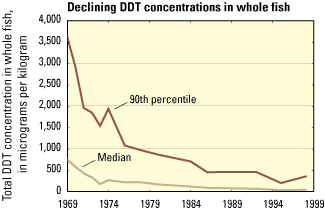
The NAWQA water-quality assessment serves as a foundation for improving water-resource assessment and management, but major gaps in critical information about pesticides still persist and continue to present challenges to scientists, managers, and policymakers. Some of the most important steps needed to fill gaps are listed below:
NAWQA assessments of pesticides followed a nationally consistent approach in 51 of the Nation's major river basins and aquifer systems, referred to as "Study Units, with 20 Study Units studied during 1992–1995; 16 during 1996–1998; and 15 during 1998–2001. Nationally, water samples for pesticide analysis were collected from 186 stream sites, bed-sediment samples were collected from 1,052 stream sites, and fish samples were collected from 700 stream sites. Ground-water samples were collected from 5,047 wells.
Most water samples were analyzed for 75 pesticides and 8 degradates, including 20 of the 25 most heavily used herbicides and 16 of the 25 most heavily used insecticides. In addition, 32 organochlorine pesticide compounds were analyzed in bed sediment and (or) fish tissue, including 19 pesticides and 13 degradates or manufacturing by-products. Most of the organochlorine pesticides are no longer used in the United States, but organochlorine compounds still persist in the environment.
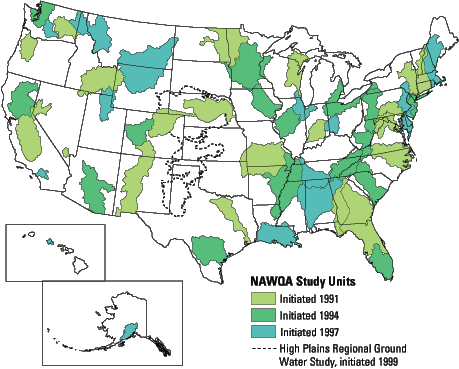
Robert J. Gilliom, Chief, National Pesticide Synthesis
U.S. Geological Survey
Placer Hall—6000 J Street
Sacramento, CA 95819-6129
Email: rgilliom@usgs.gov
(916)-278-3094
By Robert J. Gilliom and Pixie A. Hamilton
Layout and design by Phillip J. Redman
This Fact Sheet and the Circular are free of charge and are on the World Wide Web at http://water.usgs.gov/nawqa.
Document Accessibility: Adobe Systems Incorporated has information about PDFs and the visually impaired. This information provides tools to help make PDF files accessible. These tools convert Adobe PDF documents into HTML or ASCII text, which then can be read by a number of common screen-reading programs that synthesize text as audible speech. In addition, an accessible version of Adobe Reader, which contains support for screen readers, is available. These tools and the accessible reader may be obtained free from Adobe at Adobe Access.
| AccessibilityFOIAPrivacyPolicies and Notices | |
 |
|